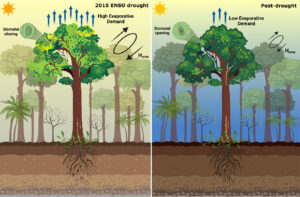Canopy-level transpiration during the 2015 ENSO-driven drought in the Central Amazon exhibited significant deviations due to exceptionally high Vapor Pressure Deficit (VPD) conditions and increased temporal differences between the peaks of stomatal conductance (gs) and VPD. This resulted in an increased hysteresis effect, as evidenced by the expanded hysteresis area (Harea) across multiple ecophysiological variables compared to the post-drought period. Image courtesy of authors.
